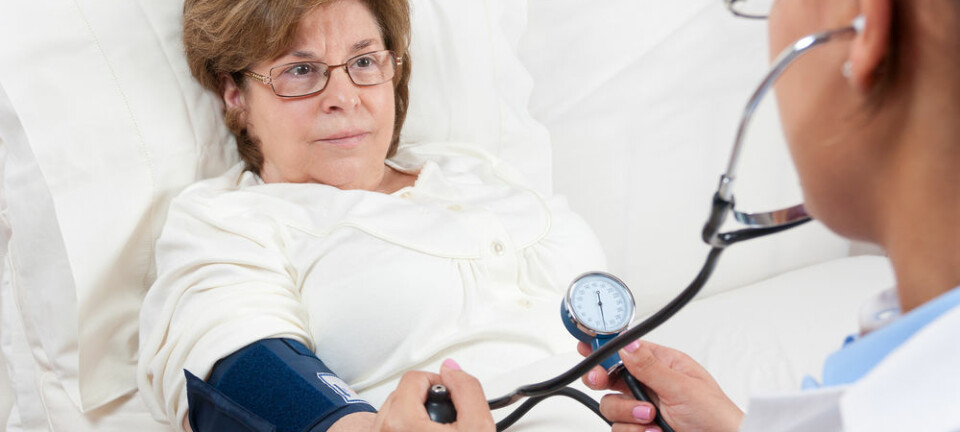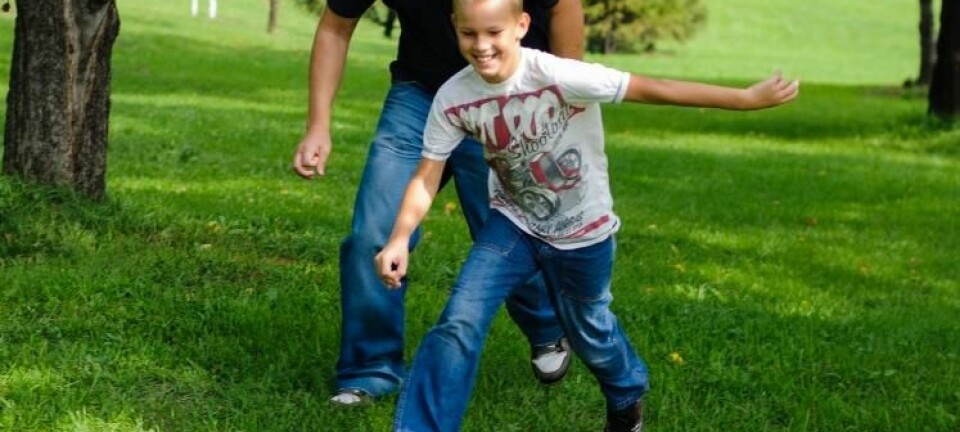
Surgical hypertension treatment no better than conventional medication
A simple surgical procedure on the kidneys has been touted as a revolutionary treatment for high blood pressure. A Norwegian study indicates that existing medication actually works better.
Denne artikkelen er over ti år gammel og kan inneholde utdatert informasjon.
Some patients with high blood pressure are resistant to common hypertension medications.
A new hope was raised for these patients a few years ago with the introduction of a medical procedure called renal sympathetic denervation (RDN).
The method involves cauterizing of some of the arterial nerves in the kidneys.
Neural activity in this area reinforces high blood pressure. The surgical treatment was designed to lower blood pressure by reducing the activity of specific nerves.
The surgical process was not very intrusive. It could be performed by inserting a special instrument through the groin, a method called the Symplicity catheter system. The catheter leads a long, flexible surgical tool into the arteries and up to the kidneys.
The method was referred to as a possible revolution in treatment of high blood pressure as recently as 2012. Tens of thousands of patients have already undergone the operation in numerous European countries.
But Chief Physician Aud Høieggen of Oslo University Hospital thinks the scientific foundation for declaring the method effective is on shaky ground.
She, along with Chief Physician Fadl Elmula and their hospital colleagues have found that the surgical procedure has less effect than already available medicines.
If doctors prescribe medicines that are clinically adjusted to the individual patient, a lot more people can avoid dangerous levels of hypertension.
The doctors have also found that many of the patients who did not appear to be helped by medications were not really resistant to the drugs.
A challenge for the health services
As a point of departure it is fully understandable that the pharmaceutical industry has attempted to devise alternatives for treatment-resistant hypertension patients.
“These are people who take three or more blood pressure reducing medications without managing to get their hypertension under control,” explains Høieggen. “There are also people who experience so many side-effects from all the medications that they cannot continue using any of them.”
These groups have posed a challenge to the health services. This explains why the initial assessment of the results from the new RDN surgical procedure were welcomed with open arms.
Good results
A small study was first published by the firm that developed the method. It showed excellent results. But the researchers had not compared the patients who had had the procedure with control groups, so it was impossible to say how much of the improvements could be attributed to the placebo effect.
Then in 2010, the controlled and randomised Symplicity II study was carried out, and it too showed good results. Many doctors and patients were intrigued by and welcomed the technique.
The EU gave the method its stamp of approval and several countries adopted it as a standard treatment for hypertension patients. Over 20,000 patients in Germany alone have had the procedure.
The USA was more restrictive. The US Food and Drug Administration demanded more research.
The results of two new studies are being released. One was the comprehensive Symplicity III Study, which is about to be completed. But the first investigation was the study by Høieggen and colleagues at the Oslo University Hospital.
The Oslo findings show that the surgical procedure does not perform as once thought.
Better with medications
“We saw an improvement in blood pressure in the group that only received the clinically adjusted drug treatment. A certain effect is seen with the RDN surgery on the kidneys, but definitely not as significant as described in the Symplicity II study,” says Høieggen.
“Six months after the RDN surgery, the patients who were on the prescription drugs had lower blood pressure than those who had undergone RDN,” she said.
Høieggen thinks she has part of the explanation for why the results from Oslo University Hospital countered the early findings: Not all the patients had actually suffered from treatment-resistant hypertension.
Some were not resistant
The Norwegian study managed to determine which patients were truly resistant to high blood pressure medicines. This entailed weeding out 46 of the 65 patients who had initially been diagnosed with treatment-resistant hypertension by their referring doctors.
Høieggen found that one of the reasons for diagnostic errors was that 14 patients were not even really taking their pills.
When the medical scientists checked to ensure that the patients were taking their meds, they saw that these drugs were effective.
It also turned out that six of the patients only had so-called “office blood pressure”. This is a term for people who simply get short-term hypertension when the doctor is taking their blood pressure – but not necessarily elsewise.
When the researchers equipped the patients with monitors that measured their blood pressure once or twice an hour throughout the day, they saw that some of the patients had normal blood pressure when outside the doctor’s office.
These two groups had not been removed from the Symplicity II study, which could explain why the results were off the mark, according the Norwegian researcher.
Unethical to continue the study
A drawback of the Norwegian study is that it is based on so few patients. Only ten participants in the group were subjected to the RDN surgery, with an equal number in the control group of patients who used medications instead. This small group of patients increases the risk of chance results.
But there was a good reason why so few were involved in the test.
“The study got too small because it was terminated early,” says Høieggen.
“We carried out a planned preliminary analysis during the study which showed that the group receiving clinically adjusted drug treatment was seeing a better effect than the group undergoing surgery. A committee then found it would be professionally unethical to expose more patients to the surgery.”
Poor results leaked
Høieggen is eager to compare the results with those of the American study, which entails 500 patients.
“Information has leaked from the study that suggest the results are not as good as hoped. Now we are waiting for the study to be published this month,” she says.
The chief physician stresses that the Norwegian results do not show the kidney procedure is useless. Some patients could benefit from RDN and it might still be an alternative for patients who cannot tolerate or use any blood pressure medications.
But in the meanwhile, nobody knows how the surgery works on people who don’t take blood pressure medications. All the patients in the studies published to date were using blood pressure regulating drugs along with having renal sympathetic denervation surgery.
Also good news
The results of the Oslo University Hospital study are probably disappointing for many patients as well as doctors.
But Høieggen suggests that there is a bright side. By means of better diagnostics and patient follow-ups, doctors might find combinations of medications that work better for the individual patient.
Another factor worth considering is that the study shows relatively many of the hypertension patients believed to be resistant to drug treatment were actually not resistant after all. They might simply have exhibited high blood pressure due to stress at the doctor’s office, or maybe they are not taking their meds as prescribed.
In such cases their medical problems could have easier solutions than anybody suspected.
------------------------------------------------
Read the Norwegian version of this article at forskning.no
Translated by: Glenn Ostling
































